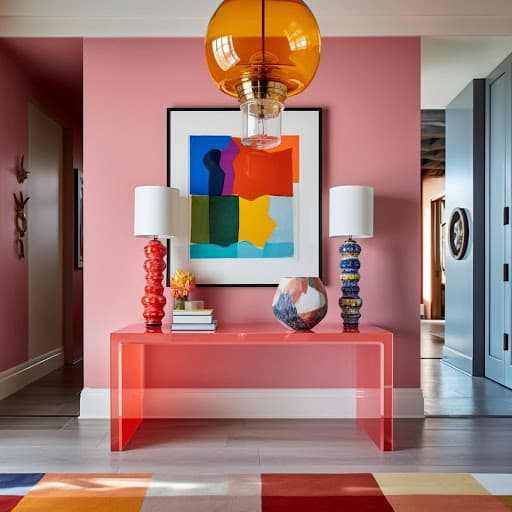Color Palette Mastery: Choosing the Perfect Hues for Your Home Design

Your home is a blank canvas, ready to be adorned with colors that mirror your style and personality. Whether you’re revamping a single room or orchestrating an entire home design, acquiring expertise in the art of color palettes is imperative. The precise fusion of hues can evoke emotions, establish harmony, and elevate the aesthetic allure of your living space. This guide is designed to guide you through the fundamentals of mastering color palettes, assisting you in selecting the ideal hues for a home that genuinely resonates with your identity.
Understanding the Basics of Color Theory
Before immersing yourself in color palettes, it’s essential to grasp the fundamentals of color theory. The color wheel, a cornerstone tool for designers, comprises primary colors (red, blue, and yellow), secondary colors (green, orange, and purple), and tertiary colors (resulting from a blend of primary and secondary colors). Complementary colors, situated opposite each other on the wheel, produce a dynamic contrast, whereas analogous colors, located adjacent to each other, yield a more subdued and harmonious effect.
Setting the Mood with Warm and Cool Tones
Take into account the mood you aim to set in each room. Warm tones such as reds, yellows, oranges contribute to a snug and welcoming atmosphere. These hues work well in living rooms and bedrooms, where warmth and comfort are sought. Conversely, cool tones like blues, greens, and purples evoke calmness and tranquility, making them well-suited for spaces like bathrooms and home offices. Striking a balance between warm and cool tones throughout your home can create a harmonious and well-rounded design.
Creating Depth with Neutral Colors
Neutral colors serve as the often-overlooked heroes of interior design. Whites, grays, and beiges act as a timeless backdrop, allowing other colors to take center stage. They foster a sense of balance, ward off visual clutter, and can impart an illusion of spaciousness to a room. Consider incorporating neutral tones for larger surfaces like walls and furniture, and then infuse pops of color through accessories and accents. This approach ensures flexibility, allowing you to update the color scheme without a significant overhaul.
Playing with Monochromatic Schemes
Explore monochromatic color schemes if you prefer a more cohesive and understated look. This entails employing various shades and tones within a single color palette. For example, a monochromatic blue scheme might include navy, sky blue, and baby blue. This approach adds sophistication and visual interest without the complexity of multiple colors. Experiment with varying intensities and textures within the chosen color for a dynamic and layered effect.

Accentuating with Bold Colors
While neutrals and subtle hues create a foundation, don’t shy away from incorporating bold colors as accents. These can be introduced through statement furniture, artwork, or accent walls. Vivid colors infuse personality and vitality into a space, establishing focal points that captivate the eye. When using bold colors, consider the overall balance and ensure they complement the existing color palette rather than overpowering it.
Testing Samples in Different Lighting
Color perception can be misleading, particularly regarding how hues respond to different lighting conditions. How colors look in a showroom or under fluorescent lights can differ significantly from how they appear in your home’s natural glow. To ensure the chosen color palette retains its impact and cohesion, it is essential to conduct thorough testing under various lighting conditions.
Start by obtaining paint or fabric samples of your chosen colors. Apply these samples to small sections of the walls or critical furniture pieces in the room. Take note of how the colors manifest during different periods of the day and under diverse lighting conditions, encompassing natural daylight, artificial illumination, and the ambient glow of the evening.
Seeking Inspiration from Nature and Art
Within the realm of color palettes, endless wellsprings of inspiration emerge from the embrace of nature and the enchantment of art. Seek inspiration in the calming greens of a forest, the vibrant hues of a lively sunset, or the subtle tones of a peaceful seascape. Immerse yourself in the works of artists whose color choices resonate with your style. Extracting colors from these abundant sources allows you to choreograph a home design that is visually pleasing and harmoniously mirrors your distinctive taste.
Conclusion
Becoming adept at manipulating color palettes is an artistic endeavor that requires a grasp of color theory fundamentals, mindful contemplation of each room’s atmosphere, and the skillful utilization of diverse schemes to fashion a unified and aesthetically pleasing design. Infusing your living space with warmth and coolness, embracing neutrals, exploring monochromatic arrangements, and introducing striking accents can make your home a captivating masterpiece. It’s essential to experiment with sample colors under various lighting conditions and draw inspiration from nature’s wonders and artistic expressions. Armed with these insights, you’ll be on the path to crafting a residence that looks superb and radiates a distinctive reflection of your style.